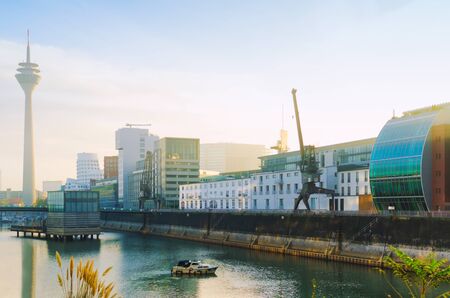Setting Off: Bold Steps Into Londons Forgotten East
We begin our adventure where the glinting towers of Canary Wharf scrape the sky, a stone’s throw from the Thames. Here, in the cool dawn mist, its easy to be fooled by the modern polish—the glass, steel, and hurried suits. But dig just beneath this glossy veneer and youll find the ghosts of London’s lost industries clinging to the shadows. The Docklands were once the beating heart of global trade, their warehouses brimming with rum, tea, and timber; now only fragments remain, hidden between luxury flats and riverside pubs. There’s a raw tension here: every step forward is a tug-of-war between relentless regeneration and stubborn history. As you lace up your boots and stride east, you can almost hear the clang of distant shipyards echoing through alleyways transformed by time. This is no gentle ramble—this is an urban expedition into what was left behind, hunting for traces of industry in a city obsessed with reinvention.
2. Docklands: From Shipyards to Shadows
Plunge headfirst into the tangled heart of London’s Docklands, where echoes of clanging metal and shouted orders still haunt the air. Once the pulsing artery of the British Empire’s maritime might, these docks are now a patchwork of silent warehouses and skeletal cranes silhouetted against the Thames. Every uneven cobblestone whispers tales of shipwrights labouring through fog and sweat, stevedores with splintered hands unloading tea chests and rum barrels, and salt-stained sailors testing fate on wild, far-off seas.
Life Along the Docks
The Docklands were not just an industrial engine—they were a crucible for communities forged in hardship and danger. Men and women built their lives here amidst the rumble of trolleys and hiss of steam engines, their fortunes rising and falling with each incoming tide.
The Work That Powered an Empire
| Role | Main Duties | Risks & Rewards |
|---|---|---|
| Shipwright | Constructing and repairing ships | High skill, risk of injury, pride in craftsmanship |
| Stevedore | Loading and unloading cargo | Physical danger, low pay, camaraderie |
| Sailor | Navigating global trade routes | Adventure, long absences, peril at sea |
The Shadows Linger
Today’s urban explorer will find a landscape transformed but not erased. Redeveloped flats perch atop old dock walls; graffiti sprawls over rusted gates that once guarded fortunes bound for every corner of the globe. Walk these streets as dusk falls, and you’ll sense the lingering bravado—a challenge issued by ghosts who shaped London’s destiny with battered hands and indomitable spirit.

3. On the Trail of the Matchgirls and Sugar Kings
Step off the well-trodden tourist map and plunge into Bow’s backstreets, where the 1888 matchgirls’ strike sparked more than just workplace reform—it ignited a firestorm of social change. Here, among red-brick remnants and faded factory gates, you’re tracing the exact footsteps of East End heroines who dared to defy Victorian tyranny. The Bryant & May match factory looms over Fairfield Road like a silent titan, its battered walls still echoing with chants for justice. Picture the audacity: teenage girls demanding dignity while phosphorous fumes gnawed at their bones. This isn’t just history—it’s rebellion etched in brick dust and soot.
Follow the Thames eastward, where Docklands’ skyline morphs from glass towers to jagged silhouettes of industry past. Silvertown rises—a name gilded by sugar but built on sweat. Here sprawled Henry Tate’s empire, its refineries spewing sweet smoke that once blanketed the city. Imagine the sticky chaos as dockers unloaded raw cane from rum-soaked ships, feeding Tate & Lyle’s insatiable hunger for gold-dust crystals. In these cavernous warehouses, fortunes were made—and lives ground down—beneath pulleys and iron beams.
This walk is no genteel stroll; it’s an adrenaline-fuelled deep dive into London’s gutsy underbelly. Every crumbling archway or rusted gate whispers stories of industrial bravado and working-class grit. From Bow’s match-striking revolutionaries to Silvertown’s sugar kings, you’re not just observing—you’re adventuring through a world where resistance was survival and every alley pulses with restless energy.
4. Factories in the East End: Fact Versus Fable
Step off the DLR and into a living relic of Londons industrial backbone—the East End. Here, beneath the soot-stained arches and through the battered gates, legends collide with the hard-edged truth of what once powered the city. Navigate abandoned biscuit factories where sweet scents have long since vanished, prowl brewery sites echoing with ghostly laughter, and squeeze through textile mills where nimble fingers wove both fortunes and misery.
Urban Myths vs. Historical Realities
The stories are thick as smog—did Queen Victoria really sample the first East End biscuit? Was the Thames Thunder ale brewed stronger to withstand dockside brawls? Locals spin yarns with cheeky pride, but the cracked tiles and rusted vats tell their own story. To separate tall tales from documented history, we need to dig beneath decades of grime and nostalgia.
Case Studies: Biscuit, Brew, and Bolt
| Factory Type | Legend | Verified Fact |
|---|---|---|
| Biscuit Factory | Royal taste-test by Queen Victoria | Site records show deliveries to Buckingham Palace, but no visit by Her Majesty herself |
| Brewery Site | Thames Thunder brewed for dockers strength | Strong ale popular among workers, but name coined by marketing in 1920s |
| Textile Mill | Mills secretly ran after dark for illicit profits | Extended shifts documented during wartime; no evidence of illegal operations as myth suggests |
Crumbled Walls, Concrete Evidence
Poking around these derelict spaces, you’ll find more than just fragments of machinery—you’ll uncover official ledgers, faded union banners, and hand-scrawled notes hidden behind loose bricks. These artefacts ground our urban adventure: proof that innovation here was born out of sheer graft and necessity. The mythic hustle of East End industry isn’t just a tale spun at the local—it’s encoded in every cracked floor tile and battered signpost you pass on this walk.
5. Street Art, Salvage, and Survival: Urban Grit Reborn
As the sun flickers through broken warehouse windows and echoes of old machinery fade, the East End pulses with a defiant new energy. This is where London’s lost industries find an unexpected afterlife—not in silence, but in colour, creativity, and chaos. Graffiti sprawls across battered brickwork, transforming derelict factories into open-air galleries. Every spray-painted mural is a battle cry against oblivion, each stencil a nod to the resilience stitched deep into East End veins.
Graffiti: The New Voice of Industry
What once was soot-stained signage now gives way to bold tags and intricate street art—Banksy’s ghost lingers here, but so do hundreds of unknown artists who claim these ruins as their canvas. Each piece tells a tale: workers’ struggles, immigrant dreams, urban myths. In Shoreditch and Hackney Wick, street art isn’t just decoration—it’s protest and homage, a wild reclaiming of spaces that industry left for dead.
Pop-Up Cafes & Repurposed Spaces
Wander deeper, and you’ll stumble upon pop-up cafes nestled inside former dock offices or shipping containers perched on gravel lots. Here, baristas serve flat whites to city explorers beneath exposed pipes and salvaged steel beams—a nod to the area’s relentless reinvention. Old warehouses morph into co-working hubs or indie markets; Victorian breweries become craft beer temples. The scent of coffee mingles with nostalgia as locals and newcomers forge community amid decay.
The New Industrial Spirit
This patchwork of creativity and survival isn’t just about aesthetics—it’s industrial grit reborn for the 21st century. Makerspaces sprout where assembly lines once thundered; start-ups thrive in spaces repurposed from rust and rubble. The East End’s legacy of hard graft endures, not in smoke-belching factories but in collaborative studios and upcycled shops. Here, survival means adaptation—where every crumbling facade hides seeds of transformation and every alleyway hums with possibility.
East End’s past may be built on iron and sweat, but its future—graffitied, caffeinated, endlessly inventive—is forged in the fearless spirit of those who refuse to let London’s industrial story end in silence.
6. Urban Legends and Late-night Reflections
As dusk falls over the Docklands, the city’s modern glass towers cast long shadows across cobbled lanes where factory whistles once pierced the smog. In this twilight, local tales surface—half-whispered, half-shouted from pub corners and street corners alike. You might hear about phantom barges drifting silently down the Thames, or the spectral clatter of printing presses in derelict warehouses. One old docker claims to have seen the ghost of a riveter pacing Limehouse Cut, still searching for his lost wages. Another East Ender swears blind that the aroma of roasting coffee lingers on Cable Street after midnight—a memory of vanished roasters.
The Price of Progress
Yet beneath these stories lies a raw reckoning. The factories that powered London’s rise are gone; their bricks repurposed, their machinery rusted into history. What did we lose when the last shipwright clocked off, or when the loom rooms fell silent? It’s more than just jobs or trades: it’s pride, solidarity, and a certain grit that gave the East End its backbone. With every new glass tower and riverside flat, there’s a risk that something essential—something fiercely local—slips through our fingers.
The Enduring Spirit
But look closer: in late-night cafés, market stalls, and street murals, you’ll find echoes of that old spirit. Londoners adapt—they always have—but they don’t forget. The stories endure in pint glasses raised to bygone mates, in community halls echoing with laughter, and in the stubborn resilience of those who refuse to let history fade away.
What Lies Beneath
Beneath London’s ever-changing skin, something tough and true endures—a legacy built on sweat, invention, and no small amount of mischief. Walk these streets at night and you’ll sense it: a restless energy that refuses to be tamed by gentrification or nostalgia. The industries may be lost, but their spirit? That remains unbreakable—etched in every brick and whispered in every legend as darkness settles over the Docklands and East End once more.

